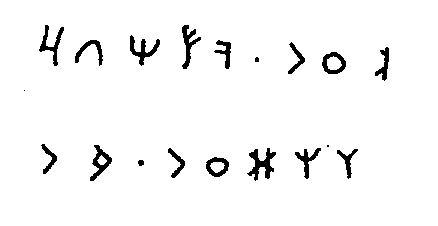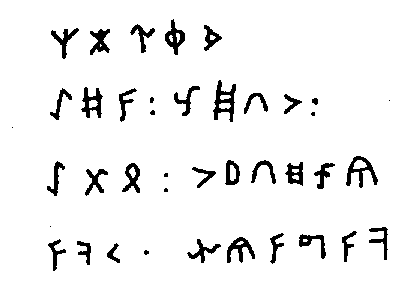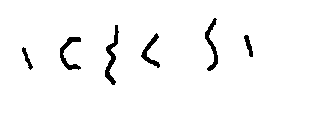SUPPLEMENT 5
PROTO-BULGARIAN RUNIC INSCRIPTION FROM THE TERRITORY OF FORMER KUBRAT
BULGARIA AND FROM IMEON (PAMIR)
1. 
One of the regal inscriptions from the territory of the Kubrat Bulgaria.
Six out of the seven characters it contains are also found in Proto-Bulgarian
inscriptions from Bulgaria. At the end of the inscription one reads clearly
the word KAN - a quite typical Proto-Bulgarian title.
Publications: Acad. G.F. Turchaninov. Monuments
of the writing and language of the peoples of the north Caucasus and Eastern
Europe ", 1971, Tab. 27-35.
2. 
All characters in this inscription have counterparts in Murfatlar and
Pliska.
3. 
One of the large inscriptions discovered in Sarkel at the Don river.
It documents the first occurrence of a character resembling the modern
Bulgarian SHT ( ) and is possibly its prototype.
) and is possibly its prototype.
4. 
Inscription whose character for the letter B resembles the later Glagolic
B. This character as well as the rest ones have their counterparts in Pliska
and Murfatlar.
5. 
The third character of this inscription is most interesting as it is
frequently found in the sacred Proto-Bulgarian inscriptions in Pliska,
in the village of Dlazhko (near Shumen) and in other places. In Dlazhko
this character occurs between the lines, together with other Proto-Bulgarian
sacred symbols.
6. 
The inscription was discovered on a stone weight for spindle from the
former Kubrat Bulgaria. It is the first occurrence of the prototype of
the letter ZH ( ), which later also appears in one
of the versions of the Cyrillic alphabet.
), which later also appears in one
of the versions of the Cyrillic alphabet.
7. 
All characters of this inscription are also found in Proto-Bulgarian
inscriptions from Bulgaria.
8. 
The second character of this inscription is most interesting. It is
found both in Murfatlar and in Caucasus, into an inscription from the Humarin
ruins. The first character is also quite characteristic - it appears on
the treasure from Nagy Saint Miklos, in Murfatlar and even in some early
Cyrillic inscriptions.
9. 
Also in this inscription one can read the word KAN in the second line,
which is a proof for its close relationship with Proto-Bulgarian language
and culture.
10. 
In contrast to the previous examples, this inscription only partly
resembles the Proto-Bulgarian ones. It can be assumed that it do not belong
to the Proto-Bulgarians but to some neighbouring people.
11. 
This is the oldest known to science runic inscription with characters
of Proto-Bulgarian type. A special feature is that the letters had been
written much more askew than it was done later. But what concerns the form
of the letters, this very archaic inscription from the VIII-IX c. BC, differs
in almost nothing from the later Proto-Bulgarian inscriptions.
12. 
In this inscription on a bronze head of an arrow can be read without
difficulties the word BOS or BUS, which has counterparts in some eastern
languages until present - for example in Chuvash. It also resembles the
Bulgarian word BOD (prick) and also the word BUCHA (to punch, to pierce
through). The word BOS or BUS was scratched exactly on a point of an arrow.
A special feature of the inscription is that the second letter, met also
in some Proto-Bulgarian inscriptions from Ravna is that it is written very
aslant (at about 45°).
[Previous] [Next]
[Back to Supplements]



 ) and is possibly its prototype.
) and is possibly its prototype.



 ), which later also appears in one
of the versions of the Cyrillic alphabet.
), which later also appears in one
of the versions of the Cyrillic alphabet.





